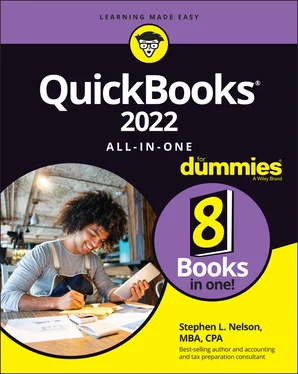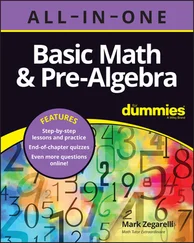9 Book 5: Financial Management Chapter 1: Ratio Analysis Some Caveats about Ratio Analysis Liquidity Ratios Leverage Ratios Activity Ratios Profitability Ratios Chapter 2: Economic Value Added Analysis Introducing the Logic of EVA Seeing EVA in Action Reviewing Some Important Points about EVA Using EVA When Your Business Has Debt Presenting Two Final Pointers And Now, a Word to My Critics Chapter 3: Capital Budgeting in a Nutshell Introducing the Theory of Capital Budgeting Calculating the Rate of Return on Capital Measuring Liquidity Thinking about Risk What Does All This Have to Do with QuickBooks?
10 Book 6: Business Plans Chapter 1: Profit-Volume-Cost Analysis Seeing How Profit-Volume-Cost Analysis Works Calculating Break-Even Points Using Real QuickBooks Data forProfit-Volume-Cost Analysis Recognizing the Downside of theProfit-Volume-Cost Model Using the Profit-Volume-Cost Analysis Workbook Chapter 2: Creating a Business Plan Forecast Reviewing Financial Statements and Ratios Using the Business Plan Workbook Understanding the Workbook Calculations Customizing the Starter Workbook Chapter 3: Writing a Business Plan What the Term “Business Plan” Means A Few Words about Strategic Plans Look, Ma: No Strategy A White-Paper Business Plan A New-Venture Plan
11 Book 7: Care and Maintenance Chapter 1: Administering QuickBooks Keeping Your Data Confidential Using QuickBooks in a Multiuser Environment Using Audit Trails Enabling Simultaneous Multiuser Access Maintaining Good Accounting Controls Chapter 2: Protecting Your Data Backing Up the QuickBooks Data File Restoring a QuickBooks Data File Condensing the QuickBooks Company Files Chapter 3: Troubleshooting Using the QuickBooks Help File and This Book Browsing Intuit’s Product-Support Website Checking Another Vendor’s Product-Support Website Tapping into Intuit’s Online and Expert Communities When All Else Fails …
12 Book 8: Appendixes Appendix A: A Crash Course in Excel Starting Excel Stopping Excel Explaining Excel’s Workbooks Putting Text, Numbers, and Formulas in Cells Writing Formulas Scrolling through Big Workbooks Copying and Cutting Cell Contents Formatting Cell Contents Recognizing That Functions Are Simply Formulas Saving and Opening Workbooks Printing Excel Workbooks One Other Thing to Know Appendix B: Government Web Resources for Businesses Bureau of Economic Analysis Bureau of Labor Statistics Census Bureau Securities and Exchange Commission Federal Reserve Government Publishing Office Internal Revenue Service Appendix C: Glossary of Accounting and Financial Terms
13 Index
14 About the Author
15 Advertisement Page
16 Connect with Dummies
17 End User License Agreement
1 Book 1 Chapter 1 TABLE 1-1 A Sales Journal TABLE 1-2 An Expenses Journal TABLE 1-3 Simple Income Statement TABLE 1-4 A Simple Balance Sheet TABLE 1-5 Owner’s Equity for a Partnership TABLE 1-6 Owner’s Equity for a Corporation TABLE 1-7 Another Simple Balance Sheet TABLE 1-8 A Simple Statement of Cash Flows TABLE 1-9 An Accounts Receivable Report at End of Day TABLE 1-10 An Inventory Report at Start of Day
2 Book 1 Chapter 2 TABLE 2-1 A Simple Income Statement for the Hot Dog Stand TABLE 2-2 A Simple Balance Sheet for the Hot Dog Stand TABLE 2-3 You Must Remember This TABLE 2-4 Journal Entry 1: Recording the Cash Sale TABLE 2-5 Journal Entry 2: Recording the Inventory Purchase TABLE 2-6 Journal Entry 3: Recording the Advertising Expense TABLE 2-7 A Trial Balance at the Start of the Day TABLE 2-8 Journal Entry 4: Recording the Rent Expense TABLE 2-9 Journal Entry 5: Recording the Wages Expense TABLE 2-10 Journal Entry 6: Recording the Supplies Expense TABLE 2-11 Journal Entry 7: Recording the Sales Revenue TABLE 2-12 Journal Entry 8: Recording the Cost of Goods Sold TABLE 2-13 Journal Entry 9: Recording the Payoff of Accounts Payable TABLE 2-14 Journal Entry 10: Recording the Payoff of the Loan TABLE 2-15 A T-Account of the Cash Account TABLE 2-16 A T-Account of the Inventory Account TABLE 2-17 A T-Account of Accounts Payable TABLE 2-18 A T-Account of the Loan Payable Account TABLE 2-19 A Trial Balance at End of Day
3 Book 1 Chapter 3 TABLE 3-1 Journal Entry 1: Recording a Credit Sale TABLE 3-2 Journal Entry 2: Recording the Customer Payment TABLE 3-3 Journal Entry 3: Recording an Allowance for Uncollectible Accounts TABLE 3-4 Journal Entry 4: Writing Off an Uncollectible Receivable TABLE 3-5 Journal Entry 5: Recording a Credit Purchase TABLE 3-6 Journal Entry 6: Recording the Payment to Vendor TABLE 3-7 Journal Entry 7: Recording an Allowance for Obsolete Inventory TABLE 3-8 Journal Entry 8: Recording Disposal of Inventory TABLE 3-9 Journal Entry 9: Recording Inventory Shrinkage TABLE 3-10 Journal Entry 10: Recording Fixed-Asset Purchase TABLE 3-11 Journal Entry 11: Recording Fixed Asset Depreciation TABLE 3-12 Journal Entry 12: Recording Fixed-Asset Sale for Gain TABLE 3-13 Journal Entry 13: Borrowing Money via a Loan TABLE 3-14 Journal Entry 14: Buying an Asset with a Loan TABLE 3-15 Journal Entry 15: Paying a Loan Payment TABLE 3-16 Journal Entry 16: Accruing a Liability TABLE 3-17 Journal Entry 17: Reversing an Accrual TABLE 3-18 Journal Entry 18: The “Real” Loan Interest Payment TABLE 3-19 A Trial Balance at the End of the Period TABLE 3-20 Journal Entry 19: Closing the Period
4 Book 2 Chapter 1 TABLE 1-1 A Trial Balance TABLE 1-2 A Trial Balance
5 Book 4 Chapter 4TABLE 4-1 A Simple Income StatementTABLE 4-2 Traditional Income Statement by Product LineTABLE 4-3 ABC Income Statement by Product Line
6 Book 5 Chapter 1TABLE 1-1 A Simple Balance SheetTABLE 1-2 A Simple Income StatementTABLE 1-3 Fixed-Charges CalculationTABLE 1-4 Income Available for Fixed Charges
7 Book 5 Chapter 2TABLE 2-1 A Simple Income StatementTABLE 2-2 A Simple Balance SheetTABLE 2-3 Estimating the All-Encompassing Capital ChargeTABLE 2-4 Simple Income StatementTABLE 2-5 A Simple Balance SheetTABLE 2-6 Estimating the New Capital Charge
8 Book 5 Chapter 3TABLE 3-1 Calculating the InvestmentTABLE 3-2 Summary of Building Cash FlowsTABLE 3-3 Estimating the Liquidation Cash FlowTABLE 3-4 Combining All Cash Flows
9 Book 6 Chapter 1TABLE 1-1 Applying the Profit-Volume-Cost FormulaTABLE 1-2 Miniature Income Statements
10 Book 7 Chapter 1TABLE 1-1 A Sample Monthly Accounting To-Do ListTABLE 1-2 A Sample Annual Accounting To-Do List
11 Appendix ATABLE A-1 Some Example Excel Formulas
1 Book 2 Chapter 1FIGURE 1-1: The QuickBooks Setup Desktop window.FIGURE 1-2: The first screen of the EasyStep Interview collects general company...FIGURE 1-3: The Filename for New Company dialog box.FIGURE 1-4: The EasyStep Interview dialog box that lets you select the start da...FIGURE 1-5: The EasyStep Interview screen shows you its recommended income and ...FIGURE 1-6: The QuickBooks Setup screen that prompts you to enter your own info...FIGURE 1-7: The QuickBooks Setup screen that collects information about the peo...FIGURE 1-8: The Make General Journal Entries window, showing a simple trial bal...FIGURE 1-9: The Make General Journal Entries window, showing the final part of ...
2 Book 2 Chapter 2FIGURE 2-1: The Chart of Accounts window.FIGURE 2-2: The first Add New Account Choose Account Type window.FIGURE 2-3: The second Add New Account window.FIGURE 2-4: The Item List window.FIGURE 2-5: The Class List window.FIGURE 2-6: The New Class dialog box.FIGURE 2-7: The Customer Information window.FIGURE 2-8: The New Customer window.FIGURE 2-9: The Payment Settings tab.FIGURE 2-10: The Additional Info tab.FIGURE 2-11: The Vendor Information window.FIGURE 2-12: The New Vendor window.FIGURE 2-13: The Payment Settings tab.FIGURE 2-14: You describe each fixed asset by using the New Item window.FIGURE 2-15: The New Sales Rep dialog box.FIGURE 2-16: The New Customer Message dialog box.
Читать дальше












